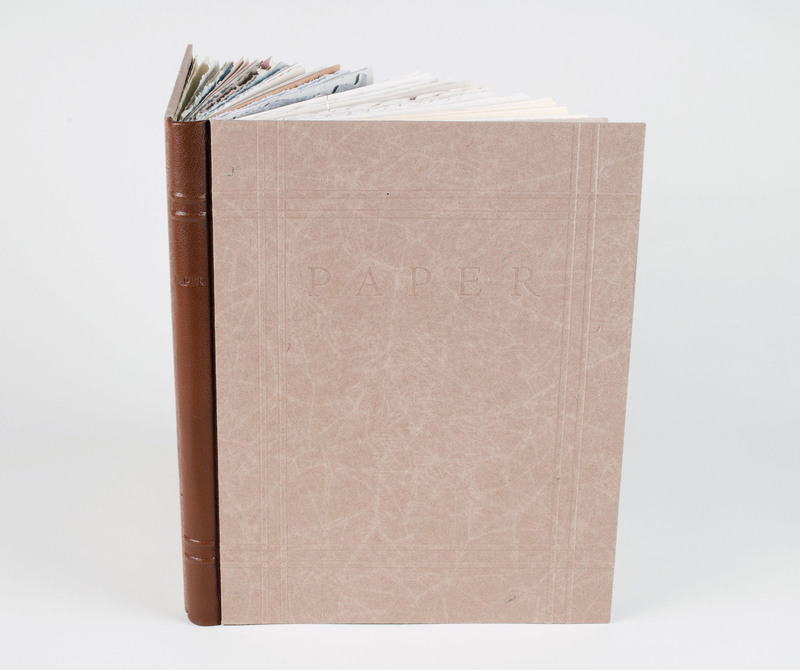A76. A Collection of Paper Samples from Hand Paper Mills in the United States of America
A76. Peter Thomas. A Collection of Paper Samples from Hand Paper Mills in the United States of America. Santa Cruz, California: Peter & Donna Thomas, 1994.
30.5 x 24 cm (12” x 9 ½”), 31 pages, 195 copies.
Binding: Copies 1-25 full-bound in brown Morocco leather. Raised relief decoration on cover. “Paper” blind-stamped on spine and cover. Raised bands on spine. Copies 26-195 quarter-bound in brown Morocco leather and light brown paper. Raised relief decoration on cover. "Paper" blind-stamped on spine and cover. Raised bands on spine. Ends sheets brown in all copies. End sheets and cover paper handmade from cotton rag half-stuff, cotton liner, and abaca by Peter Thomas in all copies. All copies housed in a brown paper wrapper tied with brown ribbon. Paper: Twenty-seven samples from papermakers folded into folios; bound in as individual signatures. All other paper handmade by Peter Thomas. Printing: Letterpress. Text printed from polymer plates. Typography: Digitally set Centaur; “PAPER” in brown on title page. Illustration: One linocut by Donna Thomas. Notes: Samples and statements were collected by Peter Thomas, who also wrote the introduction. Copies 1-25 contain seven additional samples of handmade paper from the following: The Colonial Williamsburg Foundation Paper Mill, Crazy Paper—Mary Lynn Nutting, The Historic Rittenhouse Town Paper Mill, Pyramid Atlantic, Mary Slowinski, Peter Sowinski, and Waterworks Studio.
“Finding that 1993 was officially declared the year of the craft, and, inspired by the beauty of paper sample books from the past, especially Dard Hunter’s work, we decided to create a book to honor contemporary hand papermakers and highlight the variety of visual and textural qualities found in modern handmade paper. Each of the contributors was a production papermaker, rather than paper artist, with a demonstrated history of excellence. They were asked to supply 200 sheets of 11x17 paper, of a consistent quality and weight for the project. We asked them each to write a statement about their relationship to paper. We did not want to create a papermaking manual, but rather a visual artifact that would serve to create a picture of the state of hand papermaking in 1993 for the future historian. As some papermakers we wanted to include could not supply 200 sheets, we asked them for 25 sheets and included their samples in the special copies.
This book was a further exploration into ways we could organize and arrange the page layout so that no matter where the reader opened the book they would find the page spread visually interesting. Each paper was folded as a folio, and they were sewn together in single page sections. The verso was left blank and the recto had the papermaker’s statement printed on it.
The binding is based on the one we made for the miniature book Saroyan [A64], using binder’s board glued to the cover board, but under the cover paper, to create raised bands that would refer to the blind tooled lines of a traditional leather binding. We wanted to add a leather spine to the Saroyan book’s full paper binding, but still have the raised bands span from spine to fore edge. To achieve this goal we had to invent a system where the leather was glued inside the covers (rather than on the outside as in a conventional leather spine binding). We were pretty proud of ourselves for figuring out how to do this. When we were showing it at one university the binding teacher said, ‘Oh, that binding, I teach it to all my first year students…’”
